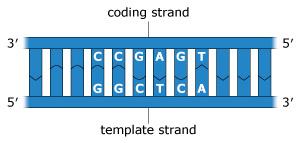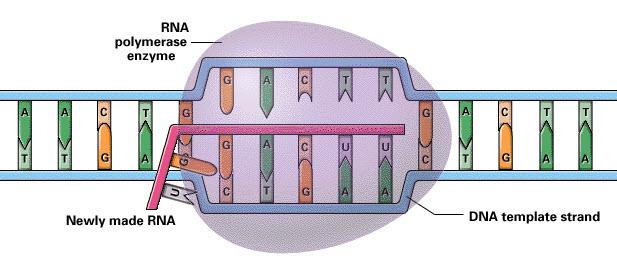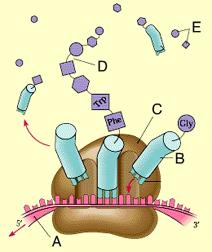Instructions for Side by Side Printing
- Print the notecards
- Fold each page in half along the solid vertical line
- Cut out the notecards by cutting along each horizontal dotted line
- Optional: Glue, tape or staple the ends of each notecard together
Chapter 17- From Gene To Protein
front 1 Aisha do item 1 | back 1 item 1 |
front 2 The flow of information in a cell proceeds in what sequence? | back 2 from DNA to RNA to protein |
front 3 A codon consists of _____ bases and specifies which _____ will be inserted into the polypeptide chain. | back 3 three ... amino acid |
front 4  In the diagram below, the gray unit represents _____. | back 4 RNA polymerase |
front 5 In the diagram below, the green unit represents _____. | back 5 the promoter |
front 6 In the diagram below, the two blue strands represent _____. | back 6 DNA |
front 7 Which of these correctly illustrates the pairing of DNA and RNA nucleotides? | back 7 GTTACG
|
front 8 The direction of synthesis of an RNA transcript is _____. | back 8 5' —> 3' |
front 9 What is the process called that converts the genetic information stored in DNA to an RNA copy? | back 9 Transcription |
front 10 DNA does not store the information to synthesize which of the following? | back 10 Organelles |
front 11 Transcription begins at a promoter. What is a promoter? | back 11 A site in DNA that recruits the RNA Polymerase |
front 12 Which of the following statements best describes the promoter of a protein-coding gene? | back 12 The promoter is a nontranscribed region of a gene. |
front 13 What determines which base is to be added to an RNA strand during transcription? | back 13 Base pairing between the DNA template strand and the RNA nucleotides |
front 14 Which of the following terms best describes the relationship between the newly synthesized RNA molecule and the DNA template strand? | back 14 Complementary |
front 15 What happens to RNA polymerase II after it has completed transcription of a gene? | back 15 It is free to bind to another promoter and begin transcription. |
front 16 What is the function of RNA polymerase? | back 16 It unwinds the double helix and adds nucleotides to a growing strand of RNA. |
front 17 Where does RNA polymerase begin transcribing a gene into mRNA? | back 17 It starts after a certain nucleotide sequence called a promoter. |
front 18 Based on this information, what is the minimum size of a codon for these hypothetical Martian life-forms? | back 18 5 bases |
front 19 Aisha do part A item 8 A & B | back 19 Aisha do part A item 8 A & B |
front 20  Enter the sequence of bases as capital letters with no spaces and no punctuation. Begin with the first base added to the growing RNA strand, and end with the last base added. | back 20 UGAGCC |
front 21 For any given gene, what ultimately determines which DNA strand serves as the template strand? | back 21 the base sequence of the gene's promoter |
front 22 Which three statements correctly describe the processing that takes place before a mature mRNA exits the nucleus? | back 22 A poly-A tail (50-250 adenine nucleotides) is added to the 3' end of the pre-mRNA.
|
front 23 During RNA processing a(n) _____ is added to the 5' end of the RNA. | back 23 modified guanine nucleotide |
front 24 During RNA processing a(n) _____ is added to the 3' end of the RNA. | back 24 a long string of adenine nucleotides |
front 25 Spliceosomes are composed of _____. | back 25 snRNPs and other proteins |
front 26 The RNA segments joined to one another by spliceosomes are _____. | back 26 exons |
front 27 Translation occurs in the _____. | back 27 cytoplasm |
front 28 After an RNA molecule is transcribed from a eukaryotic gene, what are removed and what are spliced together to produce an mRNA molecule with a continuous coding sequence? | back 28 introns ... exons |
front 29 How would this molecule have to be altered, to be used in RNA transcription? | back 29 Both (a) and (b).Add another OH to the sugar & (b) Remove a CH3 group from the base. |
front 30  You can tell this diagram is showing transcription rather than replication because ... | back 30 (b) only one strand is being used as template.
|
front 31 Which of the following statements about ribozymes is/are correct? | back 31 In some genes, intron RNA functions as a ribozyme and catalyzes its own excision.
|
front 32 The average length of a transcription unit along a eukaryotic DNA molecule is about 27,000 nucleotide pairs, whereas an averaged-sized protein is about 400 amino acids long. What is the best explanation for this fact? | back 32 Most eukaryotic genes and their RNA transcripts have long noncoding stretches of nucleotides that are not translated. |
front 33 Which of the following mutations would likely be most dangerous to a cell? | back 33 Deletion of one nucleotide |
front 34 Which of the following molecules is/are produced by translation? Include molecules that are subject to further modification after initial synthesis. | back 34 Aminoacyl-tRNA synthetase
|
front 35 Which of the following molecules are produced by transcription? | back 35 Messenger RNA & Ribozymes |
front 36 Which of the following mutations would be most likely to have a harmful effect on an organism? | back 36 a single nucleotide insertion downstream of, and close to, the start of the coding sequence |
front 37 Which component is not directly involved in translation? | back 37 DNA |
front 38 Which of these is currently considered the best definition of a gene? | back 38 A gene codes for either a polypeptide or an RNA molecule. |
front 39 What does a mutagen cause? | back 39 a change in the sequence of DNA |
front 40 True or false? A codon is a group of three bases that can specify more than one amino acid. | back 40 False |
front 41 Which of the following statements about mutations is false? | back 41 A knock-out mutation results in a total absence of the mutated protein. |
front 42 If a DNA sequence is altered from TAGCTGA to TAGTGA, what kind of mutation has occurred? | back 42 Deletion. |
front 43 Which mutation(s) would not change the remainder of the reading frame of a gene sequence that follows the mutation(s)? | back 43 One addition and one deletion mutation. |
front 44 If the sequence ATGCATGTCAATTGA were mutated such that a base were inserted after the first G and the third T were deleted, how many amino acids would be changed in the mutant protein? | back 44 Two. |
front 45 If a mutated DNA sequence produces a protein that differs in one central amino acid from the normal protein, which of the following kinds of mutations could have occurred? | back 45 An addition mutation and a deletion mutation. |
front 46 Generally speaking, which of the following mutations would most severely affect the protein coded for by a gene? | back 46 a frameshift deletion at the beginning of the gene |
front 47 How is translation initiated? | back 47 The small ribosomal subunit binds to the mRNA.
|
front 48  Which of these is a tRNA? | back 48 B |
front 49 Where does translation take place? | back 49 Ribosome |
front 50 Which nucleic acid is translated to make a protein? | back 50 mRNA |
front 51 Which of the following processes is an example of a post-translational modification? | back 51 Phosphorylation |
front 52 Which of the following steps occurs last in the initiation phase of translation? | back 52 The large ribosomal subunit joins the complex. |
front 53 At which site do new aminoacyl tRNAs enter the ribosome during elongation? | back 53 A-site |
front 54 What is meant by translocation? | back 54 The ribosome slides one codon down the mRNA. |
front 55 True or false. A tRNA with an anticodon complementary to the stop codon catalyzes the reaction by which translation is terminated. | back 55 False |
front 56 Which one of the following is true of tRNAs? | back 56 None of the above. |
front 57 What is a ribozyme? | back 57 a biological catalyst made of RNA |
front 58 What name is given to the process in which a strand of DNA is used as a template for the manufacture of a strand of pre-mRNA? | back 58 transcription |
front 59 What name is given to the process in which the information encoded in a strand of mRNA is used to construct a protein | back 59 translation |
front 60 What name is given to the process in which pre-mRNA is edited into mRNA? | back 60 RNA processing |
front 61 Polypeptides are assembled from _____. | back 61 amino acids |
front 62 RNA processing converts the RNA transcript into _____. | back 62 mRNA |
front 63 Do item 4 Part A | back 63 Aisha |
front 64 AISHA Do item 5 Part A & B on part b homework | back 64 AISHA |